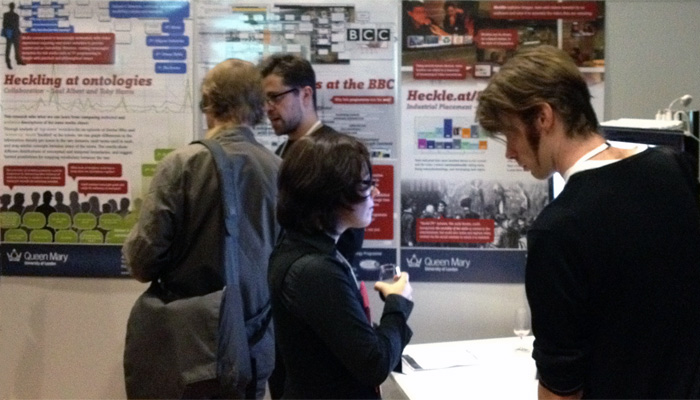‘Heckling at ontologies’ is a collaboration between myself and Saul Albert that built on our two Media and Arts Technology PhD placements. From my content modelling work at the BBC, I came away asking is it possible to model the world? who says my model is right? and who has time to it all anyway? Joining some dots between Saul’s reception-led work and my production-led work, you get to start to answer all of those, and a whole lot more.
This research created authorial descriptions and audience annotations of the same episode of Doctor Who, then compared them as media metadata.
Media is moving online, where richer metadata can enable more flexible and inter-linked production, distribution and reception processes. However, creating TV media metadata that is relevant to both authors, broadcasters and viewers is a significant practical and conceptual challenge. To investigate the differences between these contexts of media production and use, a formal, script-based media ontology was used to describe an episode of Doctor Who, which was then compared to transcripts of text-chat conversations between viewers of that episode. Results revealed a limited but potentially useful overlap in how authors, broadcasters and viewers describe and use media. Our research suggests directions that could exploit that overlap to create and evaluate media metadata in novel ways.
We’ve adapted the demonstration we staged into a video, and there’s a poster which gives a more rigorous and complete description.
The original demonstration was a visualisation of the two data-sets as the programme plays, set with three posters and our spiel. The video gets a cut down version of two of those things, and PDFs of the posters are attached to this page. The full visualisation should be live at http://heckle.at/ontologies, and all the code and data that runs it is hosted at http://github.com/qmat/ontoheckle. You’ll find an RDF file for each dataset, an html page to display the visualisation, and a whole lot of javascript to query the triplestore hosting the data and animate the results.
We’d like to develop the demonstration much further, at present its a passive display and we really should be having live heckle sessions with it. We have some ideas, ontological bingo being my favourite…
Credits
Industrial Partner - BBC Stories
- British Broadcasting Corporation
Project Collaborators - BBC Stories
- Rowena Goldman - Strategic Partnerships, BBC R&D
- Paul Rissen - BBC Future Media & Technology
- Dr. Michael Jewell - Goldsmiths College University of London
- Dr. Tassos Tombros - Queen Mary University of London
Industrial Partners - Heckle at Social TV
- BT / The People Speak
Project Collaborators - Heckle at Social TV
- Andrew Gower - BT
- Prof. Pat Healey - Queen Mary University of London





